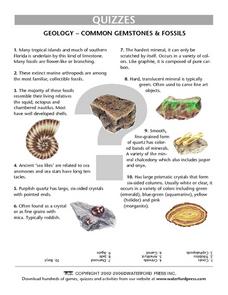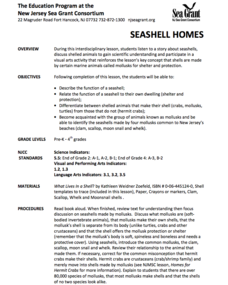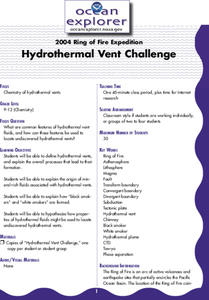Reed Novel Studies
Tales of a Fourth Grade Nothing: Novel Study
Many turtle species can retreat their heads into their shells when threatened by predators. With the Tales of a Fourth Grade Nothing novel study, pupils conduct research to uncover other interesting turtle facts. As they explore Judy...
Reed Novel Studies
Skink No Surrender: Novel Study
The oldest turtle ever recorded lived to the age of 188! As it turns out, two characters from Carl Hiaasen's Skink No Surrender are fascinated by these shelled creatures. Using the novel study, scholars research three types of turtles...
NOAA
Individual Species in the Deep Sea
A tube worm's outer covering is made of chitin, the same material that makes up the shells of lobsters and crabs. Scholars create tube worms and analyze and discuss the longevity of organisms living near cold seeps. They then discuss and...
Curated OER
The Shape of Things
Students study the natural incubation of hens and the important characteristics of the egg shell. They perform experiments to test the strength of the dome shape of an egg and prove that an eggshell has pores to allow air to pass. ...
Curated OER
Evidence of Evolution by Natural Selection: Testable Hypotheses #2
These slides will activate prior knowledge with real-life examples of natural selection. The predictions and outcomes for those examples are explained. Your students will like the information about the relevant chromosome tests that can...
University of Waikato
Ocean Acidification and Eggshells
Eggshells and seashells have a lot in common. Learners use the similarities to conduct an experiment that models the effect of ocean acidification on marine animals. Using varying levels of acidic liquids, pupils make observations on the...
DK Publishing
Big, Bigger, Biggest
Which water creature is the biggest? Youngsters look at an image of a big shell, then draw a bigger shell next to it. They do the same for a big fish. Next, learners practice with the superlative as they circle the biggest duck and frog....
Curated OER
Shhh!
What sound do fish and ship have in common? Study the /sh/ sound with your young learners. They hear a common tongue twister, spell words in their letter boxes, and read The Rainbow Fish by Marcus Phister to hear the words in context.
Curated OER
Common Gemstones and Fossils
In this science worksheet, 4th graders respond to questions pertaining to gems and fossils. Students answer ten questions which give clues and visual aids to assist in answering.
Houghton Mifflin Harcourt
Around Town: Neighborhood and Community: Extra Support Lessons (Theme 3)
Neighborhood and community is the theme of a unit comprised of extra support lessons. Following practice pages and a teach, blend, guided practice, practice/apply routine, the series of lessons provide additional reinforcement of reading...
Curated OER
The Game of Persuasion
Why is it so important to learn the art of persuasion? Being persuasive helps you acquire the things you want or the things you feel are necessary. Print out these scenarios and assign one to each group of high schoolers. As a team, they...
Mathematics Assessment Project
Representing 3-D Objects in 2-D
How does the shape of the surface of water in a container change as water leaks out? After tackling this question, learners take part in a similar activity with more complex figures.
Curated OER
The Search for Housing Pagurus hirsutiusculus= hermit crab
Students collect snail shells, measure and record their lengths and if they are occupied by a hermit crab. They discover if their is a size difference between occupied and unoccupied shells.
Curated OER
Seashell Homes
Pupils listen to a story about seashells. They discuss shelled animals. Learners describe the function of seashell. Pupils relate the function of a seashell to their own dwelling. They differentiate between shelled animals that make...
Curated OER
Homes for Hermit Crabs
Learners discover the differences between hermit crabs and mollusks and identify their parts. After reading a story about hermit crabs, they complete an anatomy worksheet. For another activity, students fold and cut a diagram of a hermit...
Curated OER
Dichotomous Keys
Students define the word dichotomous and explain why a dichotomous key is a useful tool in identifying different species. Then they look up words they are unfamiliar with or mollusk reference books so students can
learn the names of...
Curated OER
The Shape of Things
Sixth graders read and discuss information regarding the shape and attributes of an eggshell. For this shape of things lesson, 6th graders gather relevant information that pertains to the incubation and formation of an eggshell. ...
Curated OER
Models of Planets
In this planet models worksheet, students use the radius of a given planet and its mass to answer questions using a model of a planet with a given radius. They determine the volume of the planet's inner core, the volume of its outer...
Curated OER
A Tough Nut to Crack
Children, based on a set of criteria, evaluate the quality of pecans. They research recorded history of pecan trees as well as how their seeds moved across western Missouri into southeastern Kansas, Oklahoma, Texas and Mexico. In...
Curated OER
Hydrothermal Vent Challenge
Learners discover common features of hydrothermal vent fluids. They use this knowledge to locate possible undiscovered hydrothermal vents on the ocean floor.
Curated OER
Coral Reefs
Students research an inhabitant of a Caribbean coral reef using a list of common organisms that live on or near it. Students then write a description of their organism and draw a picture or a 3-D model of it. Eventually they all work...
Curated OER
Chinese Inventions
Students identify inventions as coming from China. In this Chinese inventions lesson, students are given a list of common items such as cast iron, a wheelbarrow, and the decimal system, then conduct research to identify where they were...
T. Smith Publishing
The Same Size at the Beach
Rows of Nautilus shells, beach balls, sand pails, and sea gulls array this handout. Kindergartners compare the relative sizes in each row and simply color any that are the same size. This page would make terrific take-home practice for...
Curated OER
Exploring The Oceans
In this science worksheet, students look for the information in order to answer the basic facts concerning common marine life using puzzles.
























